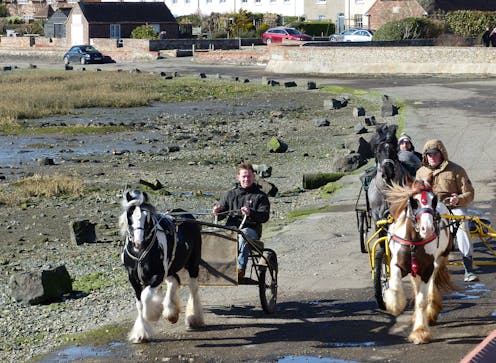
Studio 2/Shutterstock
We know well by now that coronavirus does not affect everyone equally. In England and Wales, Black people are four times more likely die from COVID-19 than white people, while people from a Bangladeshi background are twice as likely. Coronavirus has also had a disproportionate effect on people experiencing poverty.
It’s clear that this disease heightens existing inequalities. Some of the most marginalised people in the UK are Gypsy, Roma Travellers, yet they are often left out of research and outreach programmes.
We do not currently know the rates of death and severe illness among these communities. And without better data about their experiences of COVID-19, the true impacts of the pandemic on Gypsy, Roma Travellers could remain dangerously hidden.
Health inequalities
Gypsy, Roma Travellers are not a homogeneous group, but rather consist of different communities with diverse needs. Even within the same community group, there can be many varied experiences of living through the pandemic depending upon personal, social and environmental factors.
That said, research indicates that the continuing COVID-19 pandemic will be extremely challenging for many individuals within the disparate communities.
The last census in 2011 noted that 76% of Gypsy, Roma Travellers in England and Wales lived in houses or apartments. This offers the least challenging experience, as people have access to basic amenities such as electricity, gas, sanitation and water supplies.
Those living in caravans, however, are likely to experience more difficulties. A 2019 Houses of Commons briefing paper noted there were 22,662 Traveller caravans in England, of which 57% were on private sites, 29% were on local authority sites and 14% were on caravan sites. There are increased challenges for those living on these sites during the pandemic, including accessibility of gas bottles, sewerage and obtaining fresh water. Those living on unauthorised sites experience the most significant problems, especially in accessing suitable sanitation and waste disposal.
Discriminatory policies towards these communities have meant that sites, whether they are provided by a local authority or privately run, are more likely to be located close to motorways, major roads, railways, refuse tips, sewage works and industrial estates, all of which are damaging to the health of people who live there. It is perhaps not surprising therefore, that Gypsy, Roma Travellers have a worse health status than the wider community average, dying between seven to 20 years earlier than the rest of the population.
A review across five regions in England and Wales noted that 66% of Gypsy, Roma Travellers had bad, very bad or poor health. Poor air quality, proximity to industrial sites, asthma and repeated chest infections in children and older people were noted in around half of all interviews undertaken for the review. Health access is incredibly difficult for people in these communities, which means that such problems are often not picked up until much later in the illness trajectory, leading to poorly managed chronic conditions.
As COVID-19 is primarily a respiratory disease, this places Gypsy, Roma Travellers in a precarious position – many will meet the criteria for high or moderate risk.
The impact of social distancing
As well as physical health impacts, we also know that there are mental health consequences that come from the COVID-19 pandemic. These too are likely to disproportionately affect Gypsy, Roma Travellers.
These communities often have a very strong family culture, and many live in large, extended family groups. This culture is an important protective mechanism against the harsh stigma and discrimination they face in wider society.
A desire to roam and travel is also deeply embedded as a core part of the identity of Gypsy, Roma Travellers. The distancing measures enacted in response to coronavirus reduce social contact within communities as well as people’s ability to be nomadic and roam. Both of these factors have implications for the long-term mental health and well-being of people within these communities in which mental ill-health is on the increase.
A lack of data
As well as widespread stigma, a major difficulty in truly understanding the impact of coronavirus on Gypsy, Roma Traveller communities is a lack of systematic data collection.
While Gypsy, Roma Travellers were recognised as a distinct ethnic minority category in the last census, the NHS does not currently incorporate this category into their ethnicity data. As such, individuals are not identified in health services as originating from these communities. Nor are they included as a specific ethnicity in Public Health England’s reports on COVID-19 health disparities. Instead they are merged into the category of “any other white background”.
Unless this is addressed at a national level, the health impact of coronavirus on these marginalised communities will remain hidden.
![]()
Jonathan Parker is affiliated with the Green Party.
Vanessa Heaslip does not work for, consult, own shares in or receive funding from any company or organisation that would benefit from this article, and has disclosed no relevant affiliations beyond their academic appointment.

